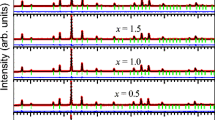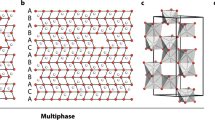Abstract
Four synthetic lepidocrocite samples with a significant difference in crystallinity have been studied by the 57Fe Mössbauer effect technique at temperatures ranging between 12 K and 360 K. In the magnetically ordered region, the spectra display broad hyperfine field distributions, the profile of which could be derived numerically. In a broad transition region of approximately 20 K, an additional doublet must be included in the fitting model. From Mössbauer thermoscanning measurements at zero-velocity and with and without the application of an external magnetic field, it is found that the doublet is due to Fe3+ species in a paramagnetic state. Neither the hyperfine field nor the Néel temperature distributions are markedly affected by the crystallinity. In the pure paramagnetic state, the broadened doublets are best described by a distribution of quadrupole splittings in the range 0.3–1.9 mm/s. By numerical manipulations of the derived probability profiles it was possible to distinguish between the iron species in the outer surface layers of the γ-FeOOH particles and those in the innermost layers, the relative amount of each being correlated with the measured surface areas. The centre shift is quite uniform and its temperature dependence, determined in detail for one of the samples, is perfectly described by the Debije approximation for the second-order Doppler shift. From the obtained Debije temperature, a Mössbauer fraction f of 0.79 at room temperature was calculated, which is in good agreement with the results obtained for a reference lepidocrocite/hematite mixture. Finally, line shape simulations aimed to explain the external field spectrum at 180 K provided strong indications that both the sign and the asymmetry parameter of the electric field gradient are non-uniform as well.
Similar content being viewed by others
References
Chambaere DG, De Grave E, Vanleerberghe RL, Vandenberghe RE (1984a) The electric field gradient at the iron sites in β-FeOOH. Hyperfine Interactions 20:249–262
Chambaere DG, De Grave E (1984b) On the Néel temperature of β-FeOOH: structural dependence and its implications. J Magn Magn Mat 42:263–268
Collins RL, Travis JC (1967) The Electric Field Gradient Tensor. In: Gruverman IJ (ed) Mössbauer Effect Methodology, Vol 3. Plenum Press, New York London, pp 123–161
Czjzek G (1983) Distribution of nuclear quadrupole splittings in amorphous materials and the topology of the (V zz,η)-parameter space. Hyperfine Interactions 14:189–194
De Grave E, Bowen LH, Hedges SW (1982) Mössbauer spectroscopy with a microprocessor: a versatile software package. Nucl Instrum Methods 200:303–310
De Grave E, Vanleerberghe R, Verdonck L, De Geyter G (1984) Mössbauer and infrared spectroscopic studies of Belgian chloritoids. Phys Chem Minerals 11:85–94
De Grave E, Verbeeck AE, Chambaere DG (1985) Influence of small aluminum substitutions on the hematite lattice. Phys Letters 107A:181–184
Ewing FJ (1935) The crystal structure of lepidocrocite. J Chem Phys 3:420–424
Govaert A, Dauwe C, Plinke P, De Grave E, De Sitter J (1976) A classification of goethite minerals based on the Mössbauer behaviour. J Phys Colloq 37:C6-825–C6-827
Heberle J (1971) The Debije integrals, the thermal shift and the Mössbauer fraction. In: Gruverman IJ (ed) Mössbauer Effect Methodology, Vol 7. Plenum Press, New York London, pp 299–308
Johnson CE (1967) Hyperfine interactions in ferrous fluosilicate. Proc Phys Soc 92:748–757
Johnson CE (1969) Antiferromagnetism of γ-FeOOH: a Mössbauer effect study. J Phys C: Solid State Phys 2:1996–2002
Klug HP, Alexander EA (1974) X-ray Diffraction Procedures for Polycrystalline and Amorphous Materials. John Wiley and Sons, New York
Meisel W, Kreysa G (1973) Relative Mössbauer-Konstanten von Eisenverbindungen zur quantitativen Analyse von Gemischen. Z Anorg Allg Chem 395:31–36
Minkova A, Schunck JP (1975) Study of superfine γ-FeOOH layers by means of the Mössbauer effect. C R Acad bulgares Sciences 28:1171–1173
Mulay LN (1963) Magnetic Susceptibility. Interscience Publishers, New York
Murad E, Schwertmann U (1984) The influence of crystallinity on the Mössbauer spectrum of lepidocrocite. Min Mag 48:507–511
Pound RV, Rebka GA Jr (1960) Variation with temperature of the energy of recoil-free gamma rays from solids. Phys Rev Letters 4:274–277
van Oosterhout GW (1965) The structure of goethite. In: Proceedings of the International Conference on Magnetism, Nottingham, 1964. The Institute of Physics and The Physical Society, London, pp 529–532
Wivel C, Mørup S (1981) Improved computational procedure for evaluation of overlapping hyperfine parameter distributions in Mössbauer spectra. J Phys E: Sci Instrum 14:605–610
Author information
Authors and Affiliations
Additional information
Research Associate at the National Fund for Scientific Research (Belgium)
Rights and permissions
About this article
Cite this article
De Grave, E., Persoons, R.M., Chambaere, D.G. et al. An 57Fe Mössbauer effect study of poorly crystalline γ-FeOOH. Phys Chem Minerals 13, 61–67 (1986). https://doi.org/10.1007/BF00307313
Received:
Issue Date:
DOI: https://doi.org/10.1007/BF00307313




